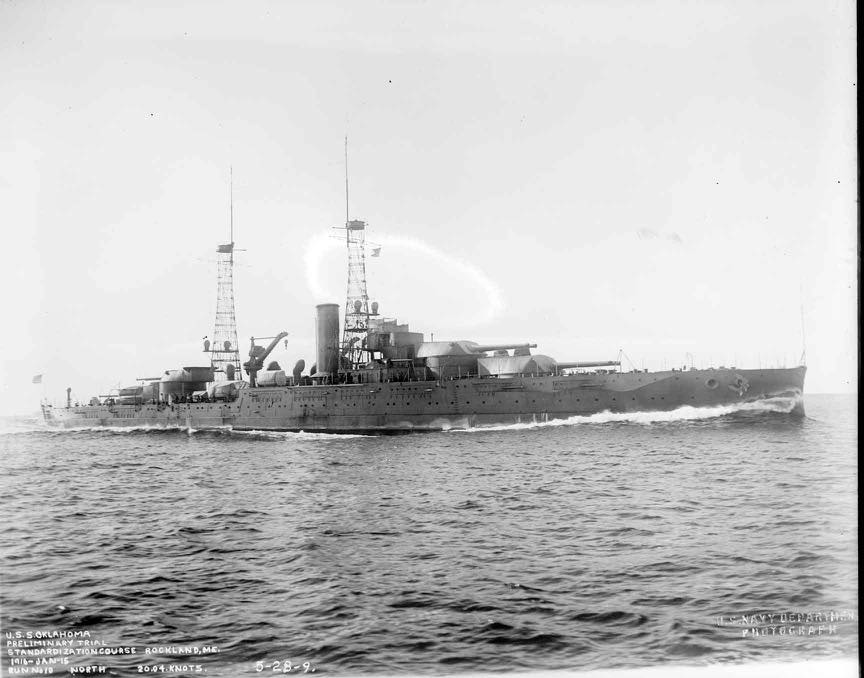USS Oklahoma BB-37

Oklahoma (BB-37: dp. 27,500; l. 583'; b. 95'3"; dr. 28'6"; s. 20.5 k.; cpl. 864; a. 10 14", 20 5", 4 21" tt.; cl. Nevada)
Oklahoma (BB-37) was laid down on October 26, 1912, by the New York Shipbuilding Corp., Camden, New Jersey; launched on March 23, 1914; sponsored by Miss Lorena J. Cruce, and commissioned in Philadelphia on May 2, 1916, with Captain Roger Welles in command.
Joining the Atlantic Fleet with Norfolk as her home port, Oklahoma trained along the eastern seaboard until departing on August 13, 1918, with her sister ship Nevada, to protect Allied convoys in European waters. In December, she was part of the escort for President Woodrow Wilson's arrival in France, leaving on the 14th for New York and winter fleet exercises in Cuban waters. She returned to Brest on June 15, 1919, to escort President Wilson in the George Washington home from his second visit to France, returning to New York on July 8.
A part of the Atlantic Fleet for the next two years, Oklahoma underwent an overhaul, trained, and twice voyaged to South America's west coast; early in 1921 for combined exercises with the Pacific Fleet, and later that year for the Peruvian Centennial. She then joined the Pacific Fleet for six years, highlighted by the Battle Fleet's cruise to Australia and New Zealand in 1925. Joining the Scouting Fleet in early 1927, Oklahoma continued intensive exercises during that summer's Midshipmen Cruise, traveling to the East Coast to embark midshipmen, carrying them through the Panama Canal to San Francisco, and returning via Cuba and Haiti.
Modernized at Philadelphia between September 1927 and July 1929, Oklahoma rejoined the Scouting Fleet for exercises in the Caribbean, returning to the west coast in June 1930 for fleet operations through spring 1936. That summer, she carried midshipmen on a European training cruise, visiting northern ports. The cruise was interrupted by the outbreak of the civil war in Spain, as Oklahoma rushed to Bilbao, arriving on July 24, 1936, to rescue American citizens and other refugees, whom she carried to Gibraltar and French ports. She returned to Norfolk on September 11, and to the West Coast on October 24.
Oklahoma's Pacific Fleet operations over the next four years included joint operations with the Army and the training of reservists.
Based at Pearl Harbor from December 6, 1940, for patrols and exercises, Oklahoma was moored in Battleship Row on December 7, 1941, when the Japanese attacked. Moored outboard alongside Maryland, Oklahoma took three torpedo hits almost immediately after the first Japanese bombs fell. As she began to capsize, two more torpedoes struck, and her crew was strafed as they abandoned ship. Within 20 minutes of the attack's start, she had capsized, halted by her masts touching the bottom, with her starboard side above water and part of her keel exposed. Many of her crew remained in the fight, boarding Maryland to help serve her anti-aircraft batteries. The attack resulted in twenty officers and 395 enlisted men either killed or missing, 32 others wounded, and many trapped within the capsized hull, saved by heroic rescue efforts. Notably, Julio DeCastro, a civilian yard worker, organized a team that saved 32 Oklahoma sailors.
The salvage operation began in March 1943, and Oklahoma entered dry dock on December 28. Decommissioned on September 1, 1944, Oklahoma was stripped of guns and superstructure and sold on December 5, 1946, to Moore Drydock Co., Oakland, California. Oklahoma parted her tow line and sank on May 17, 1947, 540 miles from Pearl Harbor en route to San Francisco.
Oklahoma received one battle star for World War II service.
 >
>